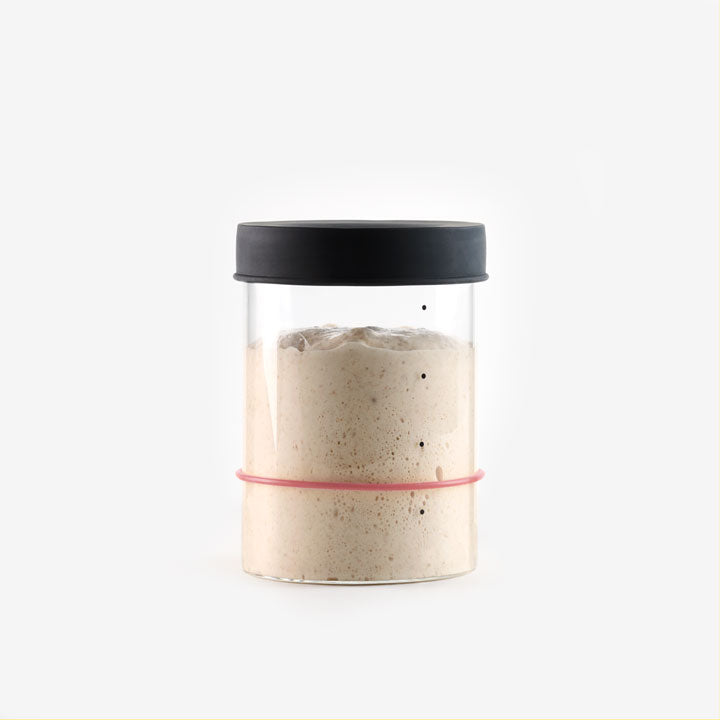Sourdough Science
Concepts for understanding sourdough baking & becoming a better baker.
THE SCIENCE & CHARM OF SOURDOUGH BAKING
No one fully understands sourdough baking. And we love that. For some bakers, it is the challenge of figuring out sourdough that makes baking fun.
Unsolved sourdough mysteries also leave room for sourdough’s romantic charm. Starter indeed feels magical in its potential help us transform inedible flour into edible breads. A starter with a hundred year old lineage can help us feel connected to the past.
Let's not attempt to remove the romance and challenge of sourdough baking. Let's just enjoy the science that helps us quickly become bakers we want to be.
Here is an ever-growing selection of concepts of sourdough science that will help you grow as a sourdough baker.
SOURDOUGH BAKING HAPPENS IN A WORLD OF MICROBES

We don't bake in a sterile environment, we live in a world of microbes. As sourdough bakers it is our job to nurture some of the useful microbes that help us create the bread we enjoy eating.
Sourdough starter is a slurry of flour and water that holds the useful yeasts and bacteria that puff up and flavor sourdough bread.
By controlling the environment and food available to our starters (and our bread dough) we cultivate the microbes we want and exclude those we don't.
SOURDOUGH IS A FERMENTED FOOD
Fermentation is a common process of pre-digestion by bacteria that releases bound up energy in food. In the case of grain, fermentation makes sugars and other nutrients available to use by the action of bacteria and yeasts.
The lactic acid bacteria commonly found in sourdough include Leuconostoc, Pediococcus, Weissella and Lactobacillus. These bacteria are the primary source of the "sour" acids that uniquely flavors sourdough bread. These acids also help break down the complex flour carbohydrates in your starter into simpler sugars that feed the sourdough yeasts.
The most common yeast species in sourdough are Kazachstania exigua (Saccharomyces exiguous), Saccharomyces cerevisiae, K. exiguus and K. humilis (previously Candida milleri or Candida humilis). These yeasts produce gases that puffs up our bread thanks to the sugars the acids create.
We don't have to be food scientists to taste the difference between naturally fermented bread and bread made with commercial yeasts. Our tongues are designed to pick up on the sugars and nutrients that fermentation releases. In this case, science helps explain why sourdough baking may offer flavor and health benefits unavailable to baking with commercial yeast.
EVERY SOURDOUGH STARTER IS UNIQUE
Your sourdough microbes in your jar are unique.
For example, research by the NC State University on 500 international sourdough starters found geographic location matter less than other factors like feeding practice and temp (sorry San Francisco).1
Saccharomyces cerevisiae (baker's yeast) was found in 70% of their samples but not all. And 70 different types of yeast were documented in total across the samples.
Take pride that your bread isn't available anywhere else in the world.
IS SOURDOUGH SAFE?
With thousands of years of human experimentation behind us 2, sourdough baking practiced with good hygiene is considered a very safe.
But why? One key factor is the acids that sourdough microbes create in a healthy starter protect the starter from unwanted intruders.
Beyond that keep good hygiene practices while baking reduce the likelihood of problems. Use clean tools and clean hands. When in doubt, throw it out.
HOW DO I KNOW IF MY STARTER HAS GONE BAD?
Tired starters can look watery, grey and flat. These starters need to be fed but aren't necessarily bad or "dead".
Sourdough starter is resilient stuff but not every microbe is equally worthy of a sourdough baker’s care. Some microbes are unsafe to eat.
If a starter gets weak from neglect, it may not be able to protect itself from intruders.
Here are three microbes to watch out for in neglected starter:



TIPS FOR AVOIDING BAD BUGS & SUCCESSFUL SOURDOUGH BAKING
- Feed your starter regularly and use clean tools to keep bad bugs at bay.
- Always keep a backup of your starter in the fridge or in a dehydrated form in case of trouble!
- When in doubt, throw it out…and refresh your back up starter.
- Keep you lid clean. Old starter on the inside of lids tend not to get refreshed and become vulnerable to intruders.
- When cleaning your jars, rinse off all soap residue and let them air dry.
References:
- https://coastalreview.org/2023/11/nc-states-sourdough-research-unlocks-microbial-mysteries/
- https://www.ncbi.nlm.nih.gov/pmc/articles/PMC6077754/
Sourhouse
Silicone Marking Bands - Limited Edition: Bad Bugs Trio
Share











